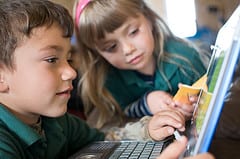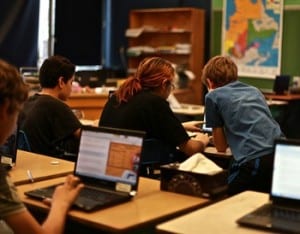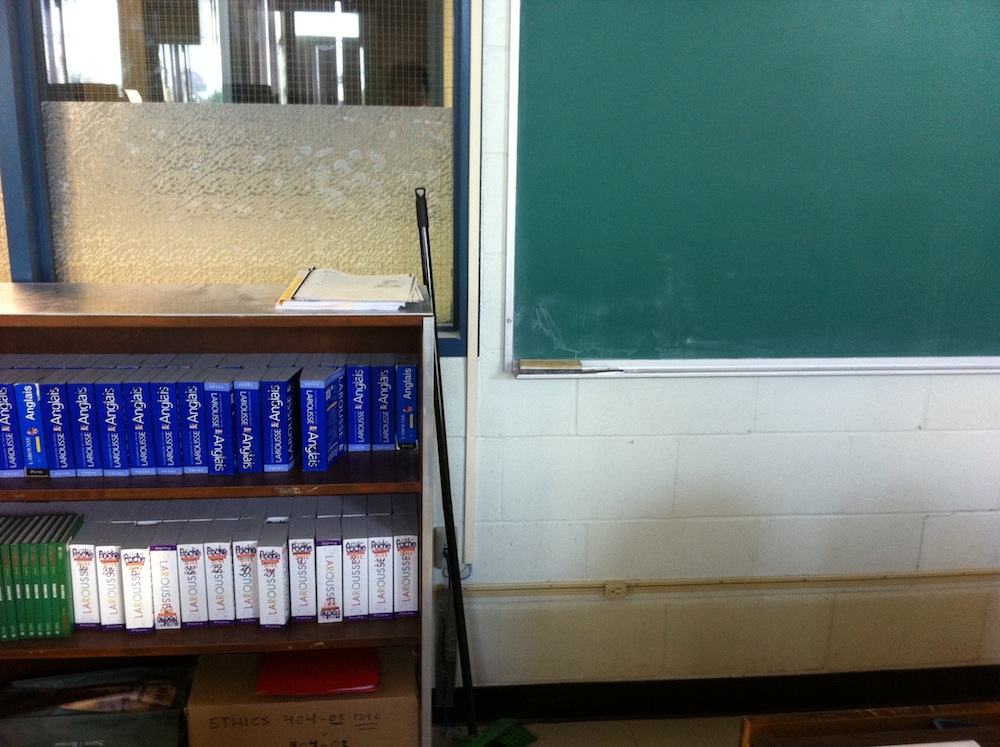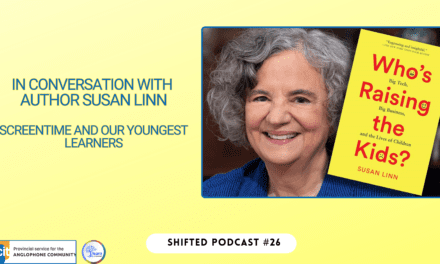 I bought my first computer in 1983 – a Franklin Ace 1000. It had 64K of memory. It functioned with floppy 5 1/4″ disks. I started taking classes at McGill in the EdTech diploma programme. One of my first courses was in Logo, manipulating a triangular “turtle”. I can remember going to my computer after putting my children to bed and doing just a little more before I, too, should get to sleep, only to find myself fixing just one more bug and one more bug until my program hummed along. I was hooked.
I bought my first computer in 1983 – a Franklin Ace 1000. It had 64K of memory. It functioned with floppy 5 1/4″ disks. I started taking classes at McGill in the EdTech diploma programme. One of my first courses was in Logo, manipulating a triangular “turtle”. I can remember going to my computer after putting my children to bed and doing just a little more before I, too, should get to sleep, only to find myself fixing just one more bug and one more bug until my program hummed along. I was hooked.
Soon after that I started volunteering to help with the computer classes at a private school and a few years later I was hired on staff. I taught students from grades 1 – 6 and a large part of my programme consisted of various iterations of Logo (Logo, Logowriter, Microworlds) and later robotics as well. It was easy to integrate the programming into projects already going on in the curriculum. There were not many in Montreal involved in teaching programming at the elementary level and I had to reach out to find like-minded people, attending and presenting at conferences (when I could get to it – the Logosium – a daylong event where educators shared) and reading Logo Express, a journal published by the logo special interest group of NECC (now ISTE).
Fast forward to 2014 and the idea of coding and children is everywhere. There is crowdsourcing to fund programmable toys. I keep seeing articles touting apps for teaching programming. Just recently I read an article about how New York City has started a project to teach teachers how to teach programming. And in the UK, programming is now part of the national curriculum. You can see the primary programme here.
I loved what programming did for my students. They learned procedural thinking, problem-solving and debugging. They had a chance to create and to control the computer instead of it controlling them. And it enabled me to see a very different side of some of my students than other teachers did. Some students, who did not sit still for other classes, were totally focussed in mine. Their ideas took flight in this new medium.
I spoke with one of my former students, Stewart Adam, who, despite the fact that he is still in university, already runs his own business. He said that the first time he gave the computer commands and it did what he wanted he felt empowered; he could control the computer. He also talked about coding as important for everyone – computers are so prevalent it is important to understand at least a little of what is going on in the background. Computers will be part of everyone’s life and jobs. He spoke about critical thinking, logical thinking, building algorithms, computational thinking as important skills that are developed through coding. It’s a unique style of thinking. He also talked about the pleasure of working with a program like Microworlds when he was in elementary school, where all students could accomplish something and be proud of what they did. Depending on the way schools introduce programming could change students perspective on it.
In the article, Learn to Code, Code to Learn, Mitch Resnick states:
I see coding (computer programming) as an extension of writing. The ability to code allows you to “write” new types of things – interactive stories, games, animations, and simulations. And, as with traditional writing, there are powerful reasons for everyone to learn to code.
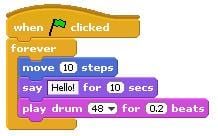 His group at the MIT Media Lab, the Lifelong Kindergarten group, is responsible for the development of Scratch, a programming language aimed at children from age 8 and up. Children (and adults) can not only learn to program, but can share their products, their questions and their pieces of code. They can learn together, remix each others’ work and build new projects, just as happens in the Open Source world. Take some time to explore the site. There is plenty there for teachers. Scratch is really yet another iteration of Logo – but with colour coding that helps people understand the logic. What I love about Scratch is, that like Microworlds, creations are only limited by the imagination of the creator.
His group at the MIT Media Lab, the Lifelong Kindergarten group, is responsible for the development of Scratch, a programming language aimed at children from age 8 and up. Children (and adults) can not only learn to program, but can share their products, their questions and their pieces of code. They can learn together, remix each others’ work and build new projects, just as happens in the Open Source world. Take some time to explore the site. There is plenty there for teachers. Scratch is really yet another iteration of Logo – but with colour coding that helps people understand the logic. What I love about Scratch is, that like Microworlds, creations are only limited by the imagination of the creator.
Code.org has challenged kids to create code, stating that anyone can learn computer science. Celebrities, both from the digital world and the pop culture world are selling the idea that coding is cool. You can find materials for teachers and students there with lots of ideas of how to implement coding lessons into a classroom.
Too often coding i.e. computer science has been kept to the upper grades of high school with the math and science top students (often male) being filtered there. Did you know that the first computer programmer was a woman? Ada Lovelace was the daughter of Lord Byron. She worked with Charles Babbage, the inventor of an early precursor to the modern computer.
I spoke with Kate Arthur and Gersande LaFleche from Kids Code Jeunesse about coding and why they felt it was important to teach coding from an early age.
Both emphasized that every aspect of people’s lives involves technology. And both emphasized the many possible jobs open to people who know how to code, everything from game development, design work, 3D modelling, work in medical modelling, animation, etc. There are many opportunities for creativity, not just for those with mathematical aptitude.
Kate, the mother of two young children, got involved because she wanted to empower children to be creative with technology rather than being controlled by it. She emphasized both the basic economics of learning to code (the field of computer science and its related fields is doubling every 2 – 3 years) as well as the self-awareness and self-esteem that comes with learning to code – that sense of empowerment that Stewart spoke about.
Through the workshops Kids Code Jeunesse has given, Kate has witnessed that learning computer programming changes a child’s enthusiasm for learning. She has seen that students tackle quite complex math writing skills via programming and see it as exciting. Other bonuses include students learning to pay attention to detail, to increase their patience as well as to build their trust in technology.
Gersande spoke about the problem of only introducing programming at a later age when many students have been filtered out. Younger children need the chance to explore and play with it to see how computers can be used to create. She talked about getting young girls interested in programming before they are filtered out by gender bias.
If we get kids when they are young they may be more likely to go into STEM fields and explore ways to work on many interesting things. It is opening doors for kids.
Programming classes result in sharing – sharing of ideas and how to do things as well as sharing of finding solutions to why things don’t work. Gersande talked about how the students became a bit competitive about finding solutions to other students’ problems. Everyone got involved, despite the fact that students were working on computers in a 1:1 situation.
Are you up for trying some coding with your students? Let your students lead you. There are countless videos on YouTube where students share their techniques, whether for Scratch, Minecraft, html or other flavours of coding. Don’t be afraid to let your students learn from others and from each other.
#################################
More Articles and sites of Interest:
Teaching Kids to Code: EdSurge Guide
15 Ways of Teaching Kids Coding by Vicki Davis: Edutopia
Schools Aren’t Teaching Kids to Code: Guess who is filling the gap
Coding for Kids – video with Chris Betcher for the K12 Online Conference
This presentation will take you on a guided tour through some of the resources available to your students to help them learn the principles of creating code. We’ll check out a range of desktop and iPad apps suitable for teaching very young students to program, through to tools and websites that can help your older students learn to hack code, and much more.
Create some art with Turtle Art and learn about coding while you play


